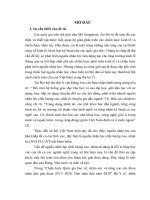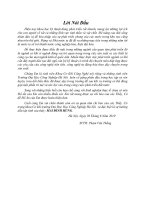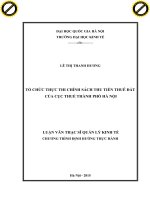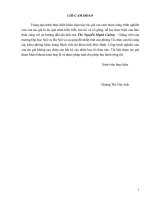Learning to listen student book 3 full plus CDs
Bạn đang xem bản rút gọn của tài liệu. Xem và tải ngay bản đầy đủ của tài liệu tại đây (19.09 MB, 77 trang )
LEARNING TO LISTE
Making sense of spoken English
Li n Lougheed
Student Book 3
�
MACMILLAN
Macmillan Education
Between Towns Road, Oxford OX4 3PP
A division of Macmillan Publishers Limited
Companies and representatives throughout the world
ISBN-13 : 978 0 333 98891 6
Text © Lin Lougheed 2003
Design and illustration © Macmillan Publishers Limited 2003
First published 2003
All rights reserved; no part of this publication may be
reproduced, stored in a retrieval system, transmitted in any
form, or by any means, electronic, mechanical, photocopying,
recording, or otherwise, without the prior written permission
of the publishers.
Designed by Xen Media Ltd
Illustrated by Kevin Hopgood, Louise Morgan, Val Saunders
and Jane Smith
Cover design by Xen Media Ltd
Cover illustration by Coneyl Jay
The publishers would like to thank Hiroshi Asano, Stuart
Bowie, James Boyd, Anthony Brewer, David Brooks, Steven R.
Brownell, Sylvia Chao, Frank Claypool, Elizabeth E. Colford,
Peter Collins, Sheelagh Conway, Ann Cunningham, Janet
Denny, Joseph Dias, Gary Farmer, Clyde Fowle, Masaki
Fujimoto, William Green, Takashi Hata, Grace Hsu, Yukari
Kanzaki, Yuko Kobayashi, Jeong Sook Lee, Mallory Leece,
Pearl Lin, Peter Littlewood, Terry McKinnon, Steve Maginn,
Richard Manuel, Charlene Mills, Harumi Nakazawa, James
Pagel, Tawatchai Pattarawongvisut, John Perkins, Rube
Redfield, Cristina Roberts, Terry Roberts, Elizabeth Root,
Satoshi Saito, Yoshiharu Saito, Maria Luiza Santos, Hajime
Shishido, Elliot Taback, Tadakuni Tajiri, Andrew Todd, Kris
Vicca, Genet Falconeri Watanabe, David Wade, Robert
Weschler, Sandra Wu, Jinsoo Yoon
The authors and publishers would like to thank the following
for permission to reproduce their photographs: Anthony
Blake/D.Dibbs p15(2), T.Hill p29(1); Corbis/R.Gehman p43(1),
G.Kufner p65(1), R.Hamilton-Smith p73(1);
Getty/R.Estakhrian p11(1), Miao China Tourism Press p11(2),
G&J Images p15(1), X. Bonghi p29(2), N.White p32, E. Stagg
p. 33(1), Yellow Dog Production p33(2), J&K Share p37(1),
K.Hatt p43(2), R.Brimson p43(3), C. Bissell p43(4),
D.A.Brandt p47(1), Yellow Dog Production p51(1), K.Chiba
p51(2), T.Anderson p52, I.Shaw p77(1), A Weber p79(1),
D.Lees p79(2); Robert Harding/Alamy p41(2); Image State pp
23(2), 37(2), 41(1), 47(2); Powerstock pp 23(1), 65(2), 73(2),
77(2).
Printed and bound in Thailand
2011 2010 2009 2008 2007
11 10 9 8 7 6 5
Contents
Scope and Sequence
4
Introduction to the Student
6
Introduction to the Teacher
7
1 Party Talk
8
2 Weekend at Home
12
3 You Haven't Changed a Bit
16
4 Pen Pals and Keypals
20
Review 1
24
5 Let's Get Something to Eat
26
6 Let's Party
30
7 Sightseeing
34
8 You're the One for Me
38
Review 2
9 Traveling Online
42
44
10 Checking In
48
11 When Are You Free?
52
12 Streaming Video
56
Review 3
60
13 E-Shopping
62
14 Shopping for Clothes
66
15 Staying Fit
70
16 Around School
74
Review 4
78
Scope and Sequence
Unit
1
Party Talk
2
Weekend at Home
Topic
Skills
Meeting people at
Identifying names and occupations
a party
Distinguishing between did you and do you
Family dinners
Identifying reasons
Identifying times and days
Distinguishing syllable stress
3
4
You Haven't Changed
Personal appearance
a Bit
Changes in appearance
Pen Pals and Keypals
Identifying people and characteristics
Distinguishing between did you do, do you
Personal interests
do, and will you do
Corresponding with
Identifying country and language
pen pals and keypals
Identifying people
Identifying place and time
Distinguishing e-mail symbols
Review 1
5
Let's Get Something
Eating at restaurants
to Eat
Identifying food and restaurants
Identifying location
Distinguishing between different
intonation patterns
6
Let's Party
Entertaining at home
Identifying actions and sequences
Identifying time and date
7
Distinguishing between lei and II/
Sightseeing
Visiting a city
Identifying places and events
Identifying transport
Identifying preferences
8
Distinguishing /sh/ and /chi
You're the One
for Me
Dating
Identifying characteristics
Identifying preferences
Distinguishing between different
intonation patterns
Review 2
4
Unit
9
Traveling Online
Topic
Skills
Using the Internet to
Identifying weather
plan vacations
Identifying activities and places
Distinguishing sentence stress
10
Checking In
Checking in at the
Identifying objects and numbers
airport
Identifying speakers and activities
Distinguishing between pronunciations of
third persons
11
When Are You Free?
Scheduling activities
Identifying times and dates
Identifying sequence of activities
Distinguishing between ordinal and
cardinal numbers
12
Streaming Video
Information about news,
Identifying topics and numbers
sports, and weather
Identifying countries
Identifying weather
Distinguishing between pronunciations of
past tense endings
Review 3
13
E-Shopping
Internet shopping
Identifying objects
Identifying problems
Identifying prices and Web addresses
14
Shopping for Clothes
Buying clothes from
Identifying preferences
a catalogue
Identifying prices and letters of the
alphabet
Distinguishing between contractions and
plurals
15
Staying Fit
16
Around School
Getting in shape
Identifying problems and solutions
Identifying objects and activities
Distinguishing between going and gone
School themes
Identifying locations and activities
Distinguishing between the past and base
forms of verbs
Review 4
5
Introduction to the Student
This series will help you become more confident about the
listening you do both inside and outside the classroom.
With these books you will:
•
learn to listen appropriately
•
learn to understand correctly
•
learn to make more sense of what you hear.
You will hear a variety of sources such as conversations,
messages, radio broadcasts, and other forms of real English,
and you will learn to listen both for detail, and for the general
meanmg.
As students you want to feel confident in real-life situations
when you are speaking English. Through this series you will
hear what real English speakers say in everyday situations,
such as meeting strangers or planning a celebration, and
learn to understand the words they use.
This series prepares you to react appropriately to the people
you meet by helping you to make sense of the meaning behind
the words they use. You will learn about the influences of a
speaker's mood, location, and background on the language she
or he uses.
You will gain confidence in listening and responding to
everyday situations in English. You'll be able to react to the
personalities of the people you meet, understand the words
they use, and make sense of what you hear.
6
Introduction to the Teacher
This three-book listening series helps make every minute of
the classroom experience as rich as the real world. The topics,
the activities, the personalities, the beliefs, and the accents
reflect the variety in the world around us. In the series,
students meet different people, discuss different things, have
different attitudes, and have different reactions.
To make the listening experience as authentic as possible, the
series presents listening challenges from a variety of sources:
dialogs, recorded messages, monologues, radio broadcasts,
reviews, public service announcements, and weather
announcements.
In these books students tackle real-world tasks that prepare
them for the kind of listening they will do outside the
classroom: listening for different purposes, making inferences,
personalizing the experience, and making assumptions and
predictions.
Students need to be actively involved in the process of
learning to listen and listening to learn, because it makes
learning much more effective. This is achieved by asking them
to listen for a purpose, read the clues about speakers' mood,
intention and background, and making students aware of the
process they use in their own native language to make
linguistic input comprehensible.
Students wish to react and express themselves appropriately
in real-life situations. For that reason, all three books show
how people react and cope in everyday situations- and they
do so in a way that shows their personality, character, and
attitude. By listening to, observing, and judging people in
these contexts, students will learn that they too are able to
express their personality when they speak English- a major
step in becoming proficient in English.
7
Party Talk
1
What's go i ng o n ?
Look at the picture and put the correct letter next to each
sentence below.
1. _ I'm sorry I have to leave so early. It was a wonderful party.
2. _ This is my friend Jack. You two have a lot in common.
3. _ Don't look now, but she's talking to Bob.
4. _ This food looks horrible. I'm glad I'm not hungry.
5. _ Robert? What a wonderful name. May I call you Bob?
6. _ Oh. I'm sorry. Are you alright?
2
Do I know yo u ?
Listen and check {wl') whether the speakers are old friends or
new friends.
Old
8
New
Old
1.
4.
2.
5.
3.
6.
New
3
What's yo u r name?
Listen and circle the correct name.
1. Tom I Thorn
3. Katie I Kathie
4. Rob I Bob
2. Leigh I Lee
4
What do you do?
Listen and check (vi' ) the correct picture.
1. a
b
3. a
b
D
2. a
b
4. a
b
lc=
•§:......
9
5
New friend s
Listen and number the pictures of what will happen next.
a.
c.
D
D
b.
D
Tra i n you r ear
Did you can be confused with do you. Listen to the examples:
ld1d3dl
When did you talk to Bill?
ldjd/
When cf,o you talk to Bill?
Listen and check (.I') if y ou hear did you or do you.
Did you
10
Do you
Did you
1.
4.
2.
5.
3.
6.
Do you
7
Test you rself
Listen and circle the answer that matches the picture.
1. (A) (B) (C)
2. (A) (B) (C)
Listen and circle the best response.
3 . (A) (B) (C)
4. (A) (B) (C)
Listen to the conversation and to the question that follows.
Circle the best answers.
5. (A) She's a lawyer.
(B) She's a doctor.
(C) She's a pilot.
8
6. (A) By bus.
(B) Around 9:00.
(C) It's so boring.
You r tu rn
Work in groups of three. D ecide on new names and professions.
Take turns introducing two of y ou together. Use this pattern:
g
g
e
!i
[
11
Weekend at Home
1
What's goi ng o n ?
Look at the picture and match the person to the description.
1. _
c_ Jane is sitting close to the kitchen door.
2. _ Jane's father, Max, is in the kitchen cooking.
3. _ Jane's twin brother, Mark, is sitting next to her.
4. _ Mark's friend, Tim, is sitting across from Mark, holding a drink.
5. _ Jane and Mark's cousin, Bill, is sitting on Tim's right.
6. _ Bill's mother, Gwen, is sitting next to Jane.
7. _ Gwen's ex-husband, Rod, is sitting next to Mark.
8.
2
_
Gwen's new husband, Matt, is sitting on Tim's left.
Who's related to who m ?
Listen to the statements about the relationships described
above. Circle the correct answer.
1. yes I no
2. yes I no
3. yes I no
4. yes I no
12
5. yes I no
6. yes I no
7. yes I no
8. yes I no
3
Why can't yo u come?
Listen and check (./) the correct excuse.
l. a
b
D
2.a
b
D
3.a
4
b
Trai n you r ear
When words have more than one sy llable, one of the sy llables is stressed
more than the others. Listen to the examples:
•
•
•
fan - tas - tic
•
•
•
ra - dish - es
(the second syllable is stressed)
(the first syllable is stressed)
Listen to the words and draw a dot over the sy llable that is stressed the
most.
1. tra-di-tion
4. re-la-tions
7. ex-cus-es
2. af-ter-noon
5. won-der-ful
3. Sa-tur-day
6. vi-si-tors
8. grand-mo-ther
9. to-mor-row
13
_.;:5�
_
Can you pi ck someth i n g up fo r me?
Listen and check (wf) what each person will bring to the
dinner.
1.
3.
a.
D
4.
2.
a.
D
b.
D
/1/j II!;
b.
6
---=-
D
a.
D
D i n ner ti m e
Listen and check (wf) the day of the dinner. Then listen again and
write the time of the dinner.
1.
2.
3.
4.
14
Monday
Tu�sday
Wednesday Thursday
Friday
Saturday
Sunday
b.
D
7
Test yo u rself
Listen and circle the answer that matches the picture.
1. (A) (B) (C)
2. (A) (B) (C)
Listen and circle the best response.
3. (A) (B) (C)
4. (A) (B) (C)
Listen to the conversation and to the question that follows.
Circle the best answers.
5. (A) Her sister.
(B) Her aunt.
6. (A) It's at 4:30.
(B) It's at 5.00.
(C) It's at 5:30.
(C) Her cousin.
8
You r turn
I nterview a partner about family dinners and complete the
chart.
YoiA
YotAr f>�rtM!.r
Who CoMe.> to yoiAr f�Mi ly di11.11.e.r>?
Who cook> the. di 11.11.e.r>?
Wh�t do yoiA IA>"IA�lly e.�t?
Wh�t tiMe. do yoiA IA>"IA�l ly e.�t?
15
You Haven't Changed a Bit
1
What's go i ng o n ?
These comments are about the people in the picture. Write
the letter of the person being talked about.
1. _ When did you grow your mustache?
2. _ Remember how thin you were and how pink your hair was?
3. _ You always wore black, didn't you?
4. _ Look how curly your hair is now! And how blond!
5. _ So you're a doctor now.
6.
Nice tattoo.
7. _ Do you still snowboard?
8. _ Your hair used to be really short, remember?
2
Same or d i fferent?
Listen and check (.f) if the person described looks the same
or different.
Same
1.
2.
3.
16
Different
4.
5.
6.
Same
Different
3
Trai n you r ear
The pronunciation of some question forms is sometimes diffi cult to
distinguish in spoken E nglish. Listen to the examples:
What did you do?
/wat d1djd du:/
What do you do?
/wat djd du:/
What will you do?
/wat wiljd du:/
Listen and check (.f) the questions y ou hear.
What did you do?
1.
2.
3.
4.
What do you do?
What will you do?
Now listen to these questions in conversations. Change y our
answers if necessary .
4
What kind of person?
00
D
5
Now and then
Listen and number each picture.
c.
a.
D
b.
D
d.
D
D
Listen again. What does each person look like now? Match
the early picture to the current picture.
g.
e.
D
h.
f.
D
6
D
How o l d are you ?
Listen and write T (Teenager), YA (Young adult: 20-25), or
A (Adult: 26 +) next to each person.
18
1.
Paul
3.
Eric
2.
Hiroko
4. _ Patty
7
Test yo u rself
Listen and circle the answer that matches the picture.
1. (A) (B) (C)
2. (A) (B) (C)
Listen and circle the best response.
3. (A) (B) (C)
4. (A) (B) (C)
Listen to the conversation and to the question that follows.
Circle the best answers.
5. (A) Thin with blond hair.
(B) Thin with dark hair.
(C) Physically fit with blond hair.
6. (A) Athletic and creative.
(B) Smart and musical.
(C) Artistic and smart.
You r turn
Ask y ourself these questions and complete the chart. Then ask
y our partner.
YotA
Wh�t did
YotAr ��rt"er
olA look. lik.e .five
How wotAld yotA de>cri be
otAr>el.f "ow'?
19
Pen Pals and Keypals
1
__
What's goi ng o n ?
Write E (e-mail) or S (snail mail) before each word. Some are
associated with both kinds of mail.
6.
1. _ stamps
mail carrier
2.
3.
_
7. _ envelope
8.
computer
4. _ word processing
5.
2
address
9.
audio files
10.
headset
Web cam
mailbox
E-mai l or s n a i l mai l ?
Listen and check (�) the way correspondence is sent.
1.
2.
3.
20
Snail mail
4.
5.
6.
Snail mail
----3
=.1-'
Where do they l ive?
Listen and match the correspondents' countries.
1. Brazil
Japan
2. Korea
China
3. Mexico
'furkey
4. Thailand
Spain
Then listen again and number the languages used in the
correspondence. One language is used twice.
Chinese
4
English
Spanish
What are you up to?
Listen and number the pictures. Then listen again and write the
last time the speaker sent an e-mail. Use:
last week
this morning
the day before yesterday
yesterday
a month ago
the week before last
a.
c.
b.
d.
D
21
_....;;:S:;...J
Tra i n you r ear
E -mail sy mbols are read like this:
•
@
means dot
means underscore
means at
means hyphen
Listen and check (.f) the correct e-mail address.
1.
2.
3.
6
D
D
D
D
D
D
missmilly9@link
smart. guy@statecollege. edu
4.
5.
6.
D
D
D
D
D
D
george.
cat.lover@camden. edu
catlover@camden. edu
gwendolin.reader@org
You are what yo u write
Listen and write R (speaker's real description) and C (speaker's cy ber
description) .
a
1.
b
c
3.
a
b
c
2.
a
b
c
4.
b
c
22
a
7
Test you rself
Listen and circle the answer that matches the picture.
1. (A) (B) (C)
2. (A) (B) (C)
Listen and circle the best response.
3 . (A) (B) (C)
4. (A) (B) (C)
Listen to the conversation and to the question that follows.
Circle the best answers.
5. (A) In England.
6. (A) She has short hair.
(C) In Japan.
(C) She has red hair.
(B) In Canada.
8
(B) She has curly hair.
You r turn
Make up an e-mail address for y ourself or use y our real one.
Ask two people for their e-mail addresses. Write them down to
make sure y ou understood correctly . Use: What is your e-mail
address?, Sorry, could you repeat that please? , at (®), dot ( . ),
underscore(_).
YotA
Pe.rso" 2
23
Review 1
Fam i ly portrait
Listen and write on the chart the number under each person in
the picture. Then listen again and write a j ob for each person.
Use: pilot, writer, French professor, computer operator, teacher, doctor.
Picture number
Job
Mom
Dad
Twin sister
Uncle
Younger sister
Cousin
Names and add resses
Listen and circle the correct name. Then listen again and match
each person's name to his or her correct e-mail address.
24
1. July I Julie
2. Bob I Rob
3. Don I Dan
cool. gal@school. edu
4. Anne I Ann
jbrowne@spring. net
Conversation review
Listen and circle the answer that matches the picture.
1. (A) (B) (C)
3. (A) (B) (C)
2. (A) (B) (C)
4. (A) (B) (C)
Listen and circle the best response.
5. (A) (B) (C)
6. (A) (B) (C)
7. (A) (B) (C)
8. (A) (B) (C)
Listen to the conversation and to the question that follows.
Circle the best answer.
9. (A) In two days.
(B) On Sunday.
(C) On Monday.
10. (A) He's a musician.
(B) He's Mexican.
(C) He plays the guitar.
25









